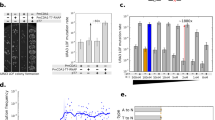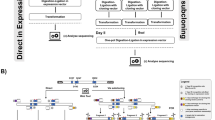Abstract
In random mutagenesis, synthesis of an NNN triplet (i.e. equiprobable A, C, G, and T at each of the three positions in the codon) could be considered an optimal nucleotide mixture because all 20 amino acids are encoded. NN(G,C) might be considered a slightly more intelligent “dope” because the entire set of amino acids is still encoded using only half as many codons. Using a general algorithm described herein, it is possible to formulate more complex doping schemes which encode specific subsets of the twenty amino acids, excluding others from the mix. Maximizing the equiprobability of amino acid residues contributing to such a subset is suggested as an optimal basis for performing semi-random mutagenesis. This is important for reducing the nucleotide complexity of combinatorial cassettes so that “sequence space” can be searched more efficiently. Computer programs have been developed to provide tables of optimized dopes compatible with automated DNA synthesizers.
This is a preview of subscription content, access via your institution
Access options
Subscribe to this journal
Receive 12 print issues and online access
$209.00 per year
only $17.42 per issue
Buy this article
- Purchase on Springer Link
- Instant access to full article PDF
Prices may be subject to local taxes which are calculated during checkout
Similar content being viewed by others
References
Youvan, D.C. 1991. Photosynthetic reaction centers: interfacing molecular genetics and optical spectroscopy. TIBS 16: 145–149.
Robles, S.J., Breton, J. and Youvan, D.C. 1990. Partial symmetrization of the photosynthetic reaction center. Science 248: 1402–1405.
Hermes, J.D., Blacklow, S.C. and Knowles, J.R. 1990. Searching sequence space by definably random mutagenesis- Improving the catalytic potency of an enzyme. Proc. Natl. Acad. Sci. USA 87: 696–700.
Sali, A., Overington, J.P., Johnson, M.S. and Blundell, T.L. 1990. From comparisons of protein sequences and structures to protein modelling and design. TIBS 15: 235–240.
Lim, W.A. and Sauer, R.T. 1989. Alternative packing arrangements in the hydrophobic core of λ represser. Nature 339: 31–36.
Reidhaarolson, J.F. and Sauer, R.T. 1988. Combinatorial cassette mutagenesis as a probe of the informational content of protein sequences. Science 241: 53–57.
Oliphant, A.R., Nussbaum, A.L. and Struhl, K. 1986. Cloning of random-sequence oligodeoxynucleotides. Gene 44: 177–183.
Kyte, J. and Doolittle, R.F. 1982. A simple method for displaying the hydropathic character of a protein. J. Mol. Biol. 157: 105–132.
Zamyatnin, A.A. 1972. Protein volume in solution. Prog. Biophys. Mol. Biol. 24: 107–123.
Arkin, A.P. 1992. Applications of machine vision and artificial intelligence to problems in protein folding. Ph.D. Thesis, M.I.T. In preparation.
Khinchin, A.I. 1957. Mathematical Foundations of Information Theory. Dover Publications, Inc., New York.
Chan, S.H. and Dill, K.A. 1990. Origins of structure in globular proteins. Proc. Natl. Acad. Sci. USA 87: 6388–6392.
Lee, C. and Levitt, M. 1991. Accurate prediction of the stability and activity effects of site-directed mutagenesis on a protein core. Nature 352: 448–451.
Sjostrom, M. and Wold, S. 1985. A multivariate study of the relationship between the genetic code and the physical-chemical properties of amino acids. J. Mol. Evol. 22: 272–277.
Yang, M.M., Coleman, W.J. and Youvan, D.C. 1990. Genetic coding algorithms for engineering membrane proteins, p. 209–218. In: Reaction Centers of Photosynthetic Bacteria, M.-E. Michel-Beyerle (Ed.). Springer-Verlag, Germany.
Zuber, H. 1990. Considerations on the structural principles of the antenna complexes of phototrophic bacteria, p. 161–180. In: Molecular Biology of Membrane-Bound Complexes in Phototrophic Bacteria. G. Drews and E. A. Dawes (Eds.). Plenum Press, New York.
Bylina, E.J., Robles, S.J. and Youvan, D.C. 1988. Directed mutations affecting the putative bacteriochlorophyll-binding sites in the light-harvesting I antenna of Rhodobacter capsulatus.. J. Israeli Chem. 28: 73–78.
Author information
Authors and Affiliations
Rights and permissions
About this article
Cite this article
Arkin, A., Youvan, D. Optimizing Nucleotide Mixtures to Encode Specific Subsets of Amino Acids for Semi-Random Mutagenesis. Nat Biotechnol 10, 297–300 (1992). https://doi.org/10.1038/nbt0392-297
Received:
Accepted:
Issue Date:
DOI: https://doi.org/10.1038/nbt0392-297



